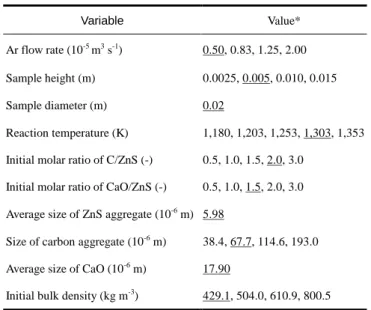行政院國家科學委員會專題研究計畫 成果報告
氧化鈣存在情況下藉由碳熱還原反應回收硫化鋅中的鋅
計畫類別: 個別型計畫
計畫編號: NSC91-2214-E-011-014-
執行期間: 91 年 08 月 01 日至 92 年 07 月 31 日 執行單位: 國立臺灣科技大學化學工程系
計畫主持人: 林俊一
報告類型: 精簡報告
處理方式: 本計畫可公開查詢
中 華 民 國 92 年 8 月 11 日
一、中文摘要
本研究探討氧化鈣存在情況下的硫化鋅碳熱還原反應。我們將裝有硫化鋅、
氧化鈣和碳黑混合粉末的坩堝置入通有氬氣的熱重分析儀中,進行化學反應。經 過一段時間後,將固體樣品取出,進行 X 光繞射分析、掃瞄式電子顯微鏡觀察及 表面積測定儀分析。此外,由熱重分析儀得到的重量變化可以算出鋅的生成率。
根據 X 光繞射儀,電子顯微鏡及表面積測定儀的結果,我們推測出化學反 應機制及化學反應模式來說明這個反應。
熱重分析儀的實驗結果發現提高氬氣流量、反應溫度、初始 C/ZnS 莫耳比 或初始 CaO/ZnS 莫耳比會提高鋅生成速率。另外,降低固體樣品高度、碳粉凝 聚團直徑或初始固體樣品密度也會使鋅生成速率上升。根據這些數據,我們迴歸 出鋅的生成速率方程式。
關健詞:氧化鈣、碳熱還原、硫化鋅 Abstract
Carbothermic reduction of zinc sulfide in the presence of calcium oxide was investigated in this study. A crucible containing power mixture of zinc sulfide, calcium oxide and carbon black was loaded in an argon flowing thermogravimetic analysis system (TGA). After a
氧化鈣存在情況下藉由碳熱還原反應回收硫化鋅中的鋅
計 畫 編 號 執 行 期 限
主 持 人
共 同 主 持 人 計 畫 參 與 人 員
:NSC-91-2214-E-011-014
:91 年 8 月 1 日至 92 年 7 月 31 日
:林俊一 台灣科技大學化工系教授
:陳鍚圭 華夏工商專校化工科教授
:黃靖翔 台灣科技大學化工系研究生 李俊賢 台灣科技大學化工系研究生
certain reaction time, the solid sample was removed and analyzed by using an X-ray diffractometer (XRD), a scanning electron microscope (SEM) and a surface area meter (BET). The results of TGA gave us the instantaneous weight of the solid sample. Zinc yield could be calculated based on the weight change of the solid sample.
According to the observations of XRD, SEM and BET, a reaction mechanism and a reaction model were proposed to interpret the reaction.
Results of TGA indicated that the rate of zinc yield could be increased by increasing the argon flow rate, the reaction temperature, the initial molar ratio of C/ZnS, or the initial molar ratio of CaO/ZnS. Furthermore, the rate was also found to be increased with a decrease in sample height, the agglomerate size of carbon black or the initial bulk density. Based on these experimental data, an empirical rate equation of zinc yield has been determined.
Keywords : Calcium oxide, Carbothermic reduction, Zinc sulfide
二、計畫緣由與目的
硫化鋅加氧化鈣的碳熱還原反應
ZnS(s)+CaO(s)+C(s)=CaS(s)+Zn(g)+CO(g)
是鋅冶煉程序及氧化鋅廢觸媒回收鋅程序中的一個重要反應。但是,相關的研究 報告只有五篇,其中只有一篇涉及動力學的探討。操作變數對反應速率影響的報 告或無一致的結論或付之厥如。更無人提及鋅生成速率式,為了補足這些缺口,
本計畫探討了七個操作變數對硫化鋅生成速率的影響。另外,根據這些數據迴歸 出鋅生成速率式。
三、研究方法與成果
先將硫化鋅、碳粉及氧化鈣分別烘乾,碳粉過篩擷取所需大小,然後把一定 比率的三種物料混合均勻後置於圓柱形坩堝中。接著將熱重分析儀在通氬氧情況 下,由室溫升至所需的溫度,待恆溫 30 分鐘後,打開熱重分析儀,置入含固體 樣品的坩堝,開始反應,到達反應時間後取出以氬氣吹冷至室溫。
實驗分成三個部份,第一部份為固定溫度變化反應時間,將反應過的樣品以
X 光繞射儀、掃描式電子顯微鏡及表面積測定儀,偵測固體樣品的化學變化及物 理變化。第二部份為固定時間變化溫度,其他的實驗方法與第一部份一樣。第三 部份改變某一個操作變數(氬氣流率、固體樣品高度、溫度、初始 C/ZnS 莫耳 比、初始 CaO/ZnS 莫耳比、碳粉凝聚團直徑及初始固體樣品密度)的值,由熱 重分析儀量取各個時間,樣品的重量,探討它對鋅生成速率的影響。操作變數的 範圍如表一所示。最後將這些數據迴歸出鋅生成速率式。
圖一所示的是在 1,303K,900s 下反應之固體樣品 X 光繞射圖;圖二所示的 是在 1,303K,10,800s 下反應的固體樣品電子顯微相片;圖三所示的是 1,303K,
不同時間下,固體樣品的表面積值。根據這些發現,我們推測出反應機制為
ZnS(s)+CaO(s)=ZnO(s)+CaS(s) ZnO(s)+CO(g)=Zn(g)+CO2(g) CO2(g)+C(s)=2CO(g)
反應模式如圖四所示。圖五所示的是反應溫度對鋅生成速率的影響圖。根據這些 數據所迴歸出的鋅生成速率式為
) s ( Y
) N Y
( N
) N Y
(N ) Y 1 ( N
Q h d ) RT / 228 , 298 (
exp 10 875 . dt 8 r dY
1 012
. 0 Zn 36 . 0 Zn ZnS
C
458 . 0 Zn ZnS CaO 408 . 0 Zn ZnS
557 . 0 o 052 . 0 528 . 199 0 . 0 c zn 8
215 . 0 zn
−
−
− −
−
−
−
−
ρ
−
×
=
=
o o
o o o
四、結論
本研究利用 X 光繞射儀,掃描式電子顯微鏡、表面積測定儀及熱重分析儀 對硫化鋅加氧化鈣碳熱還原回收鋅之化學反應進行研究,我們提出了一個化學反 應機制及反應模式來說明本反應。此外,也探討了下列七個變數對鋅生成速率之 影響:氬氣流率、固體樣品高度、溫度、初始 C/ZnS 莫耳比、初始 CaO/ZnS 莫 耳比、碳粉凝聚團直徑及初始固體樣品密度。最後迴歸出鋅生成的速率式。
五、參考文獻
[1]Abramowitz, H. and Y.K. Rao, Trans. Inst. Min. Metall (Sec. C), 87, 180(1978).
[2]Skopov, G.V., G.P. Kharitidi, A.I. Tikhonov, Izv. Vyssh Uchebn Zaved Tsvetn Metall. 4, 33(1976).
[3]Ueda, Y., T. Nakamuna and F. Noguchi, J. Min. Met. Japan, 99, 127(1983).
[4]Zhang, C., I. Asakura and O. Ogawa, J. Min. Met. Japan, 104, 469(1988).
[5]Zhang, C,I. Asakura and O. Ogawa, J. Min. Met. Japan, 104, 837(1988).
Table 1 Va l u e s o f e x p e r i m e n t a l v a r i a b l e s i n c a r b o t h e r m i c r e d u c t i o n e x p e r i m e n t s .
Variable Value*
Ar flow rate (10-5 m3 s-1) 0.50, 0.83, 1.25, 2.00 Sample height (m) 0.0025, 0.005, 0.010, 0.015
Sample diameter (m) 0.02
Reaction temperature (K) 1,180, 1,203, 1,253, 1,303, 1,353 Initial molar ratio of C/ZnS (-) 0.5, 1.0, 1.5, 2.0, 3.0
Initial molar ratio of CaO/ZnS (-) 0.5, 1.0, 1.5, 2.0, 3.0 Average size of ZnS aggregate (10-6 m) 5.98
Size of carbon aggregate (10-6 m) 38.4, 67.7, 114.6, 193.0 Average size of CaO (10-6 m) 17.90
Initial bulk density (kg m-3) 429.1, 504.0, 610.9, 800.5
* Underline values are standard operating variables.
20 30 40 50 60 70 80 90 100
0 2,000 4,000 6,000 8,000
2-theta (degree)
◇
◇ ◇
◇
◇
◇ ◇
◇
●
■
▲ZnS CaO ZnO CaS
▲
900 s
●
●
●
■
■ ■
■
■
■
■
■
▲
▲
▲
▲
▲▲
▲
▲
▲
▲ ▲
▲▲
▲
▲
▲
▲
▲
▲
Intensity
Fig.1 X-ray diffraction patterns of solid samples partially reacted
for various reaction times. Reaction temperature=1,303K.
Reaction time=10,800s
Fig.2 Scanning electronmicrographs of solid samples.
Reaction temperature = 1,303 K.
0 2,000 4,000 6,000 8,000 10,000 12,000
0 5 10 15 20
Total surface area (m2 / sample)
Time (s)
Fig.3 Plot of total surface area of partially reacted solid sample
against reaction time. Reaction temperature=1,303 K.
t=0s
t=450s
t=1,800s
t=2,700s
time
t=7,200s
t=10,800s
ZnS
ZnS ZnO
ZnS ZnO
ZnS
ZnO
ZnS ZnO
ZnS ZnO
CaO C
CaO
CaO CaS
CaO CaS
CaS
CaO CaS
CaS CaO
ˇ
Fig.4 Schematic representations of the variations of grains of ZnS, CaO and C during reaction.
0 2,000 4,000 6,000 8,000 10,000 12,000
0 20 40 60 80 100
Temperature (K) 1,180 1,303 1,203 1,353 1,253
Zinc yield, YZn(%)
Time (s) Fig.5 Plot of zinc yield against time. Effect of
reaction temperature.
行政院國家科學委員會補助專題研究計畫成果報告
※※※※※※※※※※※※※※※※※※※※※※※※※※※※※※※※
※※※※※
※ ※
※ ※
※ ※
※ ※
※ ※
※ ※
※※※※※※※※※※※※※※※※※※※※※※※※※※※※※※※※
※※※※※
計畫類別:□個別型計畫 □整合型計畫 計畫編號:NSC-91-2214-E-011-014
執行期間:91 年 8 月 1 日至 92 年 7 月 31 日
計畫主持人:林俊一 共同主持人:陳錫圭
氧化鈣存在情況下藉由碳熱還原反應回收硫化鋅中的鋅
本成果報告包括以下應繳交之附件:
□ 赴國外出差或研習心得報告一份
□ 赴大陸地區出差或研習心得報告一份
□ 出席國際學術會議心得報告及發表之論文各一份
□ 國際合作研究計畫國外研究報告書一份
執行單位:國立台灣科技大學化工系
中 華 民 國 92 年 8 月 1 日
